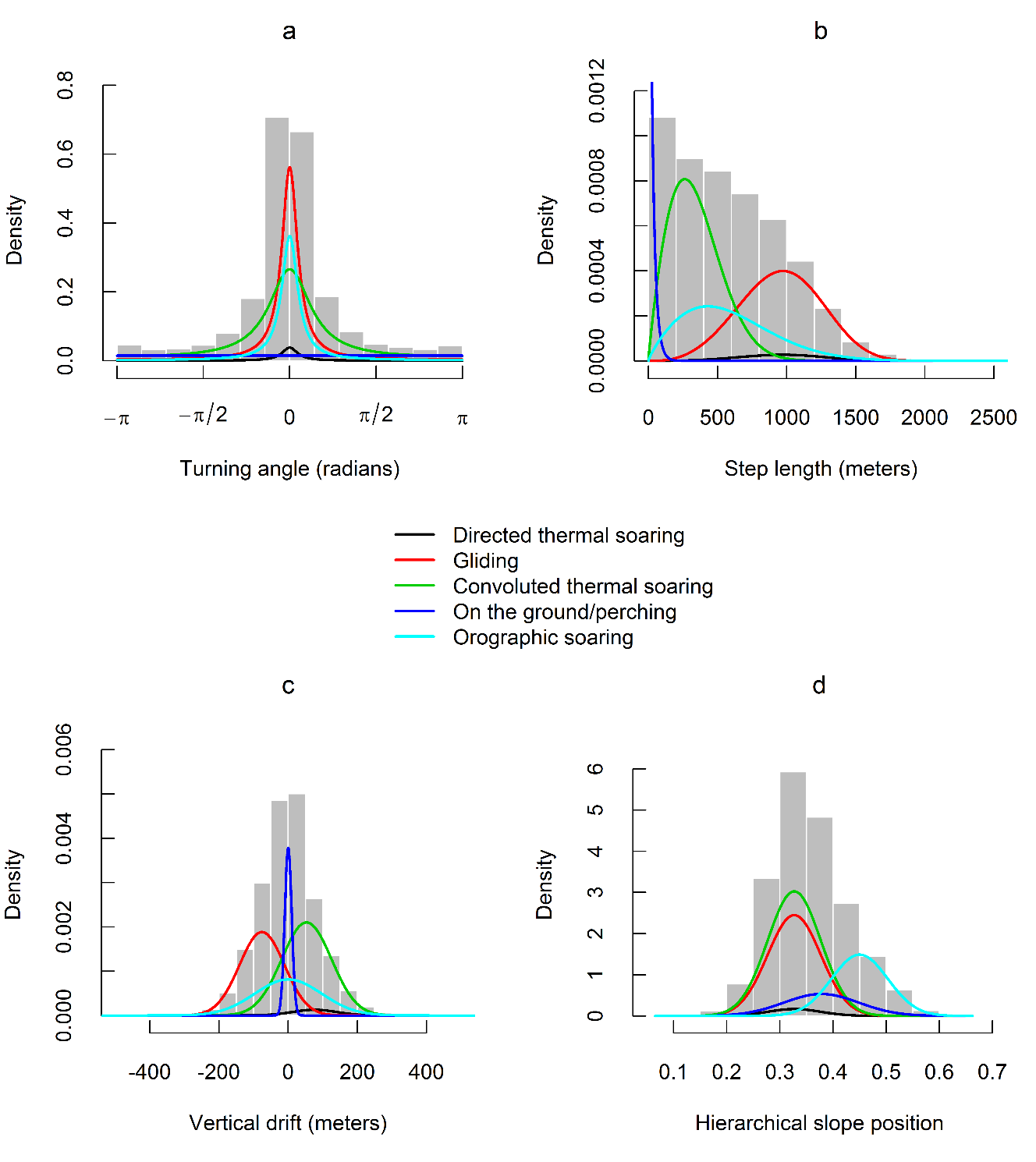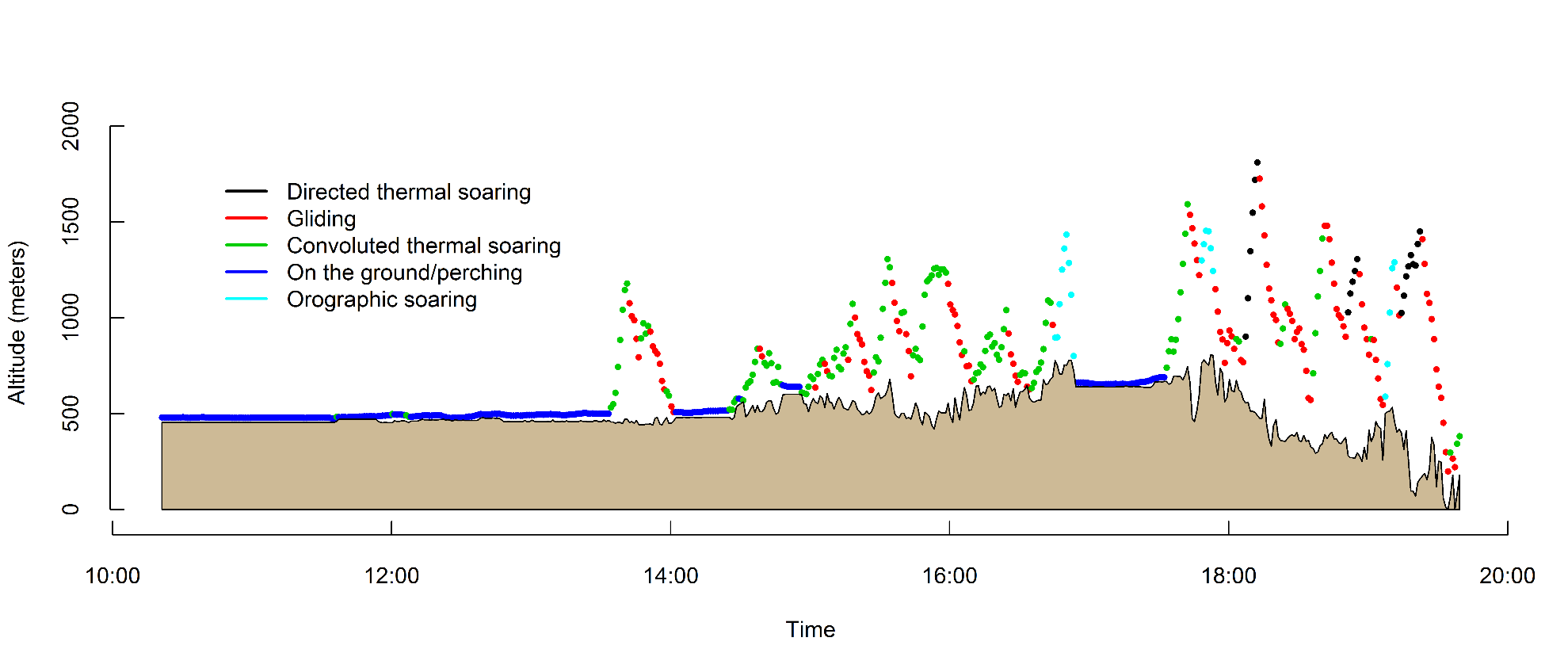State-space modelling of the flight behaviour of a soaring bird provides new insights to migratory strategies
Enrico Pirotta | Todd Katzner | Tricia A. Miller | Adam E. Duerr |Melissa A. Braham | Leslie New
Presentation Sections
- About the Authors
- Why this Paper?
- Animal Movement and Behavior
- Bayesian State-Space Models
- Let the Eagle Soar: Understanding Golden Eagle Behavior
- Results and Conclusion
Authors:
- Statisticians:
- Dr. Enrico Pirotta: Research Assistant Professor of Statistics at WSU specializing in stochastic dynamic programming models of blue whale movements.
- Dr. Leslie New: Assistant Professor of Statistics at WSU specializing in hierarchical Bayesian state-space models and their applications to ecological problems.
- Bird Experts:
- Dr. Todd Katzner: wildlife biologist at USGS focuses on developement of GPS-GSM telemetry systems for tracking migratory birds.
- Dr. Tricia Miller: wildlife biologist at Conservation Science Global (CSG) focusing on the movement ecology and conservation of raptors.
- Dr. Adam Duerr: wildlife biologist at CSG researching flight behavior of golden and bald eagles.
- Missy Braham, M.Sc.: director of data science at CSG.
Why this Paper?
My research will expand on Dr. Pirotta model via the addition of a hierarchical structure in order to study the ontogeny of bald eagle movement.
Motivation
- Animal behavior is often difficult to observe directly.
- Telemetry data provide observations of an animal's position and velocity.
- Statistical analyses of these data allow us to infer animal behavior based on their movements.
- Understading animal behavior helps conservation policy implementation.
State-Space Models (SSM)
Given a sequence of observations, a SSM assumes that there is a hidden process behind them. Each observation at a given time is emitted via some distribution given a hidden state, and the observations are independent of each other. The hidden process has the Markov property, i.e. the state at time $t$ only depends on the state at time $t-1$.Also Called a Hidden Markov Model (HMM)

Definition
The discrete-time finite state HMM is completely defined as follows:- Number of states, $K$, i.e. latent patterns of interest.
- Transition probability matrix $\Gamma$, for the hidden states $X$: $P(X_t = j | X_{t-1} = i)$ for $i,j \in \{1, \dots, K\}$.
- State-dependent distributions for the observations $Y$ that stem from the latent states: $f(Y_t|X_t = k) \Rightarrow$ any valid distribution function.
- Initial state distribution, $\delta$, i.e. the first pattern exhibited: $P(X_1 = k)$.
Likelihoods
- Complete-data likelihood: $$f(\mathbf{y, x}) = \mathcal{L}_c = \delta_{x_1}\prod\limits_{t=2}^T\gamma_{x_{t-1}, x_t}\prod\limits_{t=1}^Tf_{x_t}(y_t).$$
- Marginal likelihood: $$\mathcal{L}_m = \sum\limits_{x_1 = 1}^N \cdots \sum\limits_{x_T=1}^N\delta_{x_1}\prod\limits_{t=2}^T\gamma_{x_{t-1}, x_t}\prod\limits_{t=1}^Tf_{x_t}(y_t).$$
Priors
Since we are taking a Bayesian approach, we will need some priors. HMMs have three main sets of parameters for which we can specify prior distributions. Parameters pertaining to:
- state dependent distributions,
- the initial state distribution, and
- transition probabilities.
Golden Eagle Data
- Lon, lat, and alt above sea level from 2009 to 2016.
- Every 30-60 seconds from sunrise to sunset.
- 58 tracks: 48 spring, 10 autumn; 8 juveniles, 22 subadults, 28 adults; 19 females, 39 males.
- Dataset was cleaned and regularized to 1 minute time steps (response variables were linearly interpolated).
- 4 variables at each time $t$: step length, turning angle, altitude above sea leavel and hierarchical slope position.
Tracking Eagles

State-Dependent Distributions
- Step lenght: $l_t | X_t = i \sim \mathrm{Weibull}(\beta_i, \alpha_i)$.
- Turning angle: $\theta_t | X_t = i \sim w\mathrm{Cauchy}(\mu = 0, \rho_i)$.
- Altitude: $\nu_t | X_t = i \sim \mathcal{N}(\nu_{t-1} + \pi_i,\sigma_i)$, and to account for measurement errors $a_t \sim \mathcal{N}(\nu_t, \epsilon = 25)$.
- Hierarchical Slope Position: $h_t | X_t = i \sim \mathcal{N}(\kappa_i, \omega_i)$.
Number of States
In unsurpervised inference, the number of states is driven by the process generating the observed data.
By choosing appropriate movement and environmental variables, we can identify biologically meaningful hidden states.
A model with 5 states converged and lined-up with biological expectations: directed thermal soaring (state 1), gliding (state 2), convoluted thermal soaring (state 3), perching (state 4) and orographic soaring (state 5).

Initial Distribution and State Transition Probabilities
The initial state distribution $\delta_{x_1}$, as well as the transition probabilties $\gamma_{x_{t-1}, x_t}$ from state $X_{t-1} = i$ to all states $X_t = j = 1,\dots, 5$, were assigned the prior Dirichilet$(1,1,1,1,1)$.
Model Fit and Validation
- Model was specified in JAGS via the R package rjags, and convergence was evaluated using the R package coda.
- Convergence of three parallel chains was assessed by monitoring the proportion of minutes spent in each state, and confirmed by an $\hat{R}$ close to 1 (see results).
- Posterior state classifications where compared to manual classification (confusion matrix) and goodness of fit was assessed via posterior predictive checks.
Behavioral Models
Upon obtaining the the behavioral modes from the SSM, the authors used the lme4 package in R to fit various binomial mixed-effect models in order to indentify differences in the proportion of modes given age and season. Only flight modes were considered. Individual and year were included as random factors.
Results


| (in %) | DTS | Gliding | CTS | Perching | OS |
|---|---|---|---|---|---|
| Overall | 2 | 31 | 38 | 9 | 20 |
| Spring | 3 | 32 | 37 | 10 | 18 |
| Autumn | 0 | 24 | 43 | 8 | 25 |

Conclusion
- The model presented here is the first example of a state-space model for bird flight that uses altitude together with horizontal locations.
- Using an unsupervised technique, their model identified five functional behavior modes from the observed data, including a previously unknown behavior mode.
- Understanding the flight behavior of migrating birds can inform conservation managers and shape policies for the distribution of renewable energy equipment.